It was the first time I'd walked around the PNU campus itself, and I was struck by the sense of scale. Apparently the campus comprises of over seventy buildings which progressively work their way up a mountainside, and they are sufficiently dispersed within the grounds to require a shuttle bus to get around. Because the area is heavily forested, it's difficult to get an overall picture of the campus when walking around it - tree-lined roads suddenly give way to another faculty building, otherwise you could be anywhere. Hidden away amongst the trees various student activities are taking place - such as a kumdo practice and the university Korean drumming squad which I could hear coming from a particularly densely wooded area but regrettably not see.
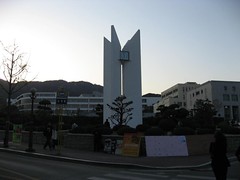
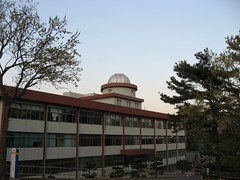
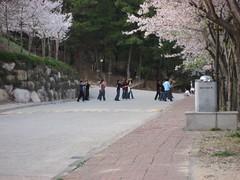
I was impressed by the building with its own observatory sat on top of it, pleased to finally see some cherry blossom up close (the campus was full of it), and amused at the terrible grammar of the English explanatory signs in a conservation area near the English Literature building. Clearly they take their conservation seriously here - so much so that one of the roads has three trees in it presumably because they didn't want to cut them down.
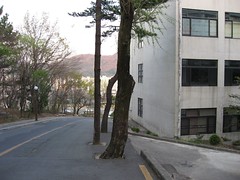
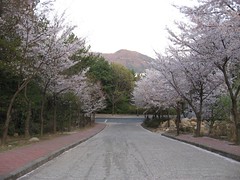
One of the buildings is called '10.16', in memory of a student uprising on the PNU campus against the military government, on the 16th October 1979, part of the so-called Busan-Masan Democratic Uprising. The uprising was brutally repressed and there were deaths, though exactly what happened and the number killed is still uncertain to this day; the uprising happened in a chaotic time and in the context of wider uprisings across the country which ultimately failed. As a former student union president in the safer surrounds of a British university, I felt rather humbled by it. Sometimes I see protests in Korea on TV and the protesters seem to take things too far, but I think I must bear in mind how hard some Koreans have fought to bring their country this far.
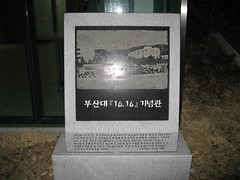
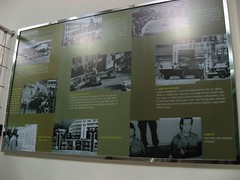
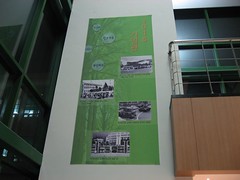
The 10.16 Building was the venue for the free 'harmonica concert', which was being given by Jeon Jeduk, an apparently famous Korean musician who regularly performed sell-out concerts in Seoul, but was on a rare foray to the allegedly culturally-challenged city of Busan to raise awareness of disability issues and sell a few albums. The organisers were worried that the turnout might not be good, but they needn't have concerned themselves - by the time the concert started the auditorium had people sat in the isles and stood at the back - probably an audience of several hundred in total. But we were fortunate enough to find ourselves in the second row with reserved seating - having been invited to the event by a highly-organised pan-flute club, which one of our friends is a member of.
One of the problems of being a foreigner in Korea and not speaking the language is that it's hard to know what's going on, and make decisions about what to do, because information is often sparse. If someone had told me that Jeon Jeduk was a jazz musician I would have been only too eager to come to the event - I can always make time for some live jazz - as it was I nearly didn't go and it would have been a great pity to miss it because the performance was excellent. Accompanied only by a jazz pianist (an excellent musician in his own right) Jeon Jeduk played a few pieces over the course of an hour, followed by fifteen minutes of encores during which he sang Imagine and a Stevie Wonder's Isn't She Lovely.
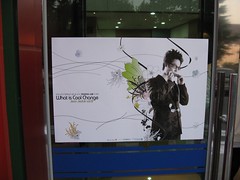
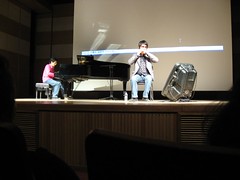
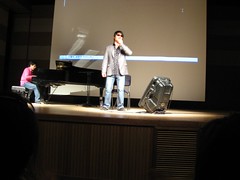
During the performance, he talked for several minutes about the experience of disabled people, and how often they just wanted to be treated as people but how all that most people in Korea saw was their disability. Being blind himself, he recognised that part of the reason he'd become so famous was because of his blindness, but there had come a point where he wanted to be appreciated for his music, not his disability. Yet, when interviewed by the media, all the interviewers ever wanted to know about was his disability, so he'd decided to withdraw from the media spotlight, appearing on TV and in movies as much as possible, play more concerts and let his music do the talking for him.
When we'd arrived at the entrance to the PNU campus earlier, we were greeted by the sight of a concert raising awareness of the 'comfort women' issue. When we left, the concert was still going on, but by now a former 'comfort woman' had taken to the stage to tell the story of how she was seized by Japanese soldiers at the age of 15 and how, because of the psychological scars, she'd never got married and had endured a difficult life. I was close enough to see the tears running down her face as she related her abuse. Many of the surviving 'comfort women' in Korea attend art therapy classes and some examples of their work were shown on the screens behind the stage. The particular woman on stage found relief in singing so she sang a song to the audience after relating her story (although as the Wikipedia article on 'comfort women' reminds its visitors - "the neutrality and factual accuracy of this article are disputed" - in other words, if you're a Japanese Government Minister you think she's a liar and presumably World War 2 was merely a misunderstanding based on a lot of Japanese men deciding to go on overseas holidays at the same time).
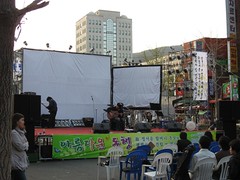
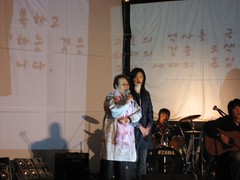
No comments:
Post a Comment